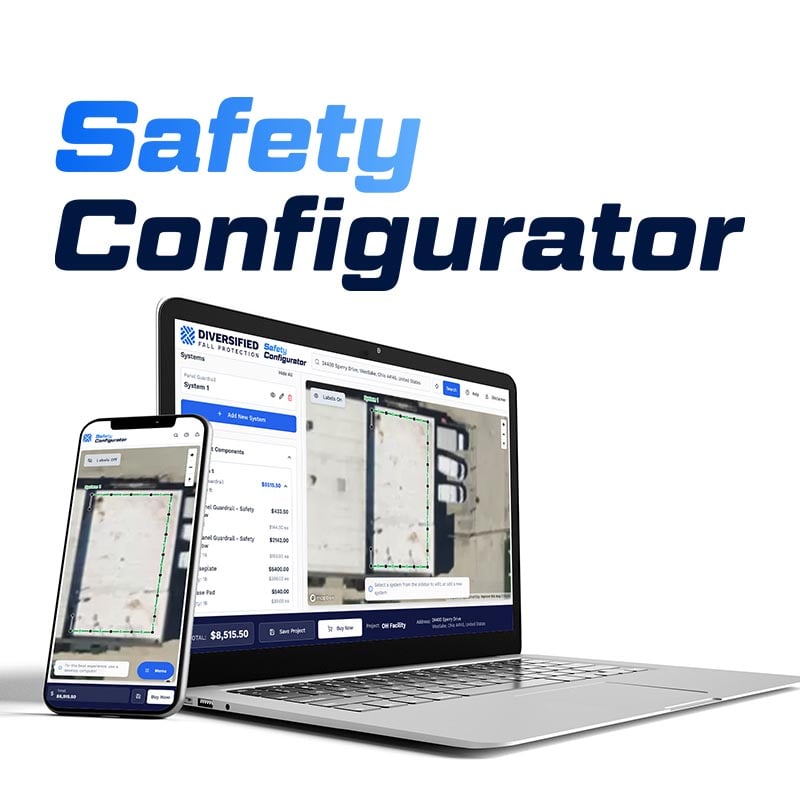Guardrail versus cable based lifelines: Which fall safety product is right for you?
For any company with a rooftop, fall protection is essential to keep workers safe during inspections, maintenance or repairs. As a matter of law, OSHA’s General Duty Clause requires employers to provide workplaces free from recognized hazards likely to cause death or serious physical harm.
It’s clear fall protection is something every company should be paying attention to, but understanding the importance of fall safety is just the first step. With so many fall protection systems to choose from, some employers are left wondering what is the best option to protect employees at heights?
In this blog post, we review two of our most popular safety systems: roof guardrails versus cable based lifelines, comparing their pros and cons head-to-head.
What are my roof protection options?
Before you decide on a fall safety solution for your facility, it’s important to consider your options. There are many fall protection systems available, but when it comes to rooftop safety, guardrails and cable based lifeline systems are often popular choices.
Roof guardrail systems
Designed for flexibility and versatility, weighted base roof guardrail systems are a great, low maintenance option for rooftop protection. These lightweight, non-penetrating guardrails are compatible with nearly all commercial roof materials and provide perimeter fall protection without requiring cumbersome equipment or user training.
Cable based lifelines
In areas with significant adequate fall clearance, cable based lifelines may be a more appropriate fall protection solution. Whether you’re building a new construction and need compliant fall protection or you’re looking to improve the existing safety systems in your facility, horizontal lifelines can be custom engineered to meet your needs.
Roof guardrail versus cable based lifelines

Advantages of roof guardrail systems:
- Weighted bases do not require roof penetration
- Design allows for maximum range of motion
- Workers do not need training
- Rescue plans are not required
- No cost of annual inspections and recertifications

Disadvantages of roof guardrail systems:
- May be more expensive up front, especially for larger rooftop applications
- Not appropriate for steep slope roofs
- May be visible from ground level

Advantages of cable based lifelines:
- Systems are not visible from ground level
- Appropriate for steep roof pitch applications
- Often more cost-effective, especially for larger rooftop applications
- Fall restraint and fall arrest properties

Disadvantages of cable based lifelines:
- Roof penetration may cause leaks if not properly flashed
- Requires installation by a manufacturer trained, certified installer
- Worker training is required per OSHA regulations
- Personal protective equipment must be inspected prior to each use
- Requires a documented rescue plan and training to ensure OSHA compliance
- Requires annual inspections and recertifications
- Worker mobility and fall protection coverage are dictated by the system design
- Recordkeeping and documentation are required per OSHA regulations
Which fall protection system is right for me?
Most employers want the best safety solution for their employees, but “best” can mean different things to different people. Some companies evaluate safety decisions exclusively on price while some value solutions that are easy to use or reduce the likelihood of human error. Other decisionmakers may look for solutions that minimize physical alterations to the roof or products that comply with OSHA regulations and ANSI guidelines.
Selecting the right rooftop fall protection solution for your application requires careful consideration of budget, risk tolerance, as well as the physical attributes of competing system styles. Only after weighing each of these factors can a decisionmaker arrive at the best solution for a given application.
One of the top strategies for assessing your system requirements is to partner with a fall protection company that can offer a thorough assessment of your rooftop. An in-person, on-site visit is always preferred, but in situations where in-person contact is restricted, Diversified Fall Protection can perform a virtual rooftop assessment using aerial imagery.
Schedule an inspection with Diversified Fall Protection
Contact Us to request a fall safety review.
Schedule an assessment with Diversified Fall Protection
Contact Us to request a fall safety review

b-1.jpg?width=1368&height=1340&name=Rail%20(175)b-1.jpg)

